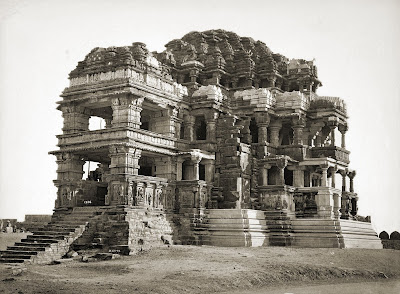The Bakhshali Manuscript, is an ancient Indian mathematical manuscript, important, interesting, with a touch of mystery, and at the same time fascinating too. Bakhshali Manuscript has been recognized by Oxford University as the world’s first recorded utilization of the numerical symbol for zero, five hundred years earlier than suspected. It was previously thought that the earliest documented instance of using zero was a ninth-century inscription on a wall in a Gwalior temple, India.
 |
| Bakhshali manuscript, was written on birch tree barkImage Source: wikimedia |
Discovery:
The manuscript was
found in 1881 in
the village of Bakhshali of undivided India, but now in Pakistan. The first research on
the ancient manuscript was done by A. F. R. Hoernlé,
(German-British Orientalist),
after it was unearthed from a field. This ancient and
important historical manuscript, was written on birch tree bark, therefore
making it very fragile. But preserved as best as possible, at a constant
temperature, and low humidity, in the Bodleian Library, of the University of
Oxford. The manuscript is written in
seventy leaves of bark, it is about different kinds of equations, like
quadratic, linear, second degree, and indeterminate equations.
 | |
|
Contents:
Also has explanations
about arithmetic, algebra, and geometry problems. Beautiful in its own right,
as mathematics is. It is interesting how the mathematical problems were
written. The author wrote the problems in verse, after solved, and explained,
this was written in prose, by using this innovative way, it is easier to remember,
and understand, all this important and useful.
Carbon Dating:
There is some degree of
disagreement as to when these manuscripts were originally written. Carbon
dating of different portions of the manuscripts suggested three different centuries,
sometime between AD 224–383, 680–779,and AD 885 to 993, results from radiocarbon dating of
other portions. A slight mystery is how pieces of this manuscript from
different centuries were added together, perhaps, leaves from the manuscript
were preserved through the centuries, and more were added.
Interesting facts about the Bakhshali Manuscript:
It seem that probably, its original author was, Chajaka's son, (a "king of calculators," for the use of Vasiṣṭha's son Hasika ) a Brahmin. In the manuscript a dot inside a circle, Sunya, or bindu, was a way to represent zero, at that time, and could be one of the oldest representation of zero. Even older than the one in the Gwalior Temple in M.P. The manuscript also includes quotes from the Hindu Scriptures, square roots, arithmetic, and geometrical progressions, and measurements. Hundreds of zeroes were discovered in the text,the idea of the symbol as we now understand and use it originated as a small dot, commonly used as a 'placeholder' to describe magnitude instructions in the ancient scheme of Indian numbers – for reference 10s, 100s, and 1000s. It features prominently in the manuscript of Bakhshali, commonly recognized as the oldest Indian document of mathematics. The fact that the Bodleian Library kept the manuscript not available to other scholars has made a great difference in the study of this fascinating manuscript as made. It seems through the years even different times local languages had been added, from Sanskrit to local languages. Due to the fragility of the leaves, it is not easy for this important manuscript to be really examined, and studied. We hope this great manuscript will be preserved for many future generations. In a statement Oxford university said,
“Scientists from the University of
Oxford’s Bodleian Libraries, have used carbon dating to trace the figure’s
origins to the famous ancient Indian scroll,"
The Science Museum in London displays a folio from the Bakhshali manuscript as the
centerpiece of the main exhibition, Illuminating India: 5000 Years of Science and Innovation By exploring its important contributions to topics as varied as space exploration,mathematics, communication and engineering, the exhibition celebrates India's high
position in the history of science and technology.

No comments:
Post a Comment
Please do not enter any spam link in the comment box. Thanks for reading our articles.